The Moto G (2015) Review
by Brandon Chester on August 19, 2015 8:00 AM EST- Posted in
- Smartphones
- Mobile
System Performance
Like the 2015 Moto E, the Moto G uses Qualcomm's Snapdragon 410 MSM8916 SoC. This is the first time Motorola has updated the SoC in the Moto G, with both the first and second generation models using the same 1.2GHz Snapdragon 400 SoC. Because the Moto G shares an SoC with the Moto E one might think this means they are equal in speed. However, the SKU in the Moto G has a peak frequency of 1.4GHz rather than the 1.2GHz in the Moto E. This is somewhat confusing because both are named MSM8916, but it's not dissimilar to how Snapdragon 615 devices run at either 1.5GHz or 1.7GHz on the big cluster.
As far as clock speed goes, the Moto G is 17% faster than the Moto E. It's difficult to estimate how much improvement will be seen compared to the older Moto G models, as the core architecture moves from Cortex A7 to Cortex A53 which comes with its own improvements in IPC in addition to the higher clock speed. It's also important to note that we are testing the model of the Moto G with 2GB of RAM, and this is another factor that can increase performance when comparing to Motorola's 1GB devices. Ultimately, it's important not to assume how much faster the Moto G will be based purely on the CPU frequency, even though it can give some idea about performance relative to other devices with the same CPU but a lower frequency. In order to properly characterize the Moto G's performance relative to many other devices, we turn to our standard workflow of web based benchmarks, followed by PCMark and BaseMark OS II.
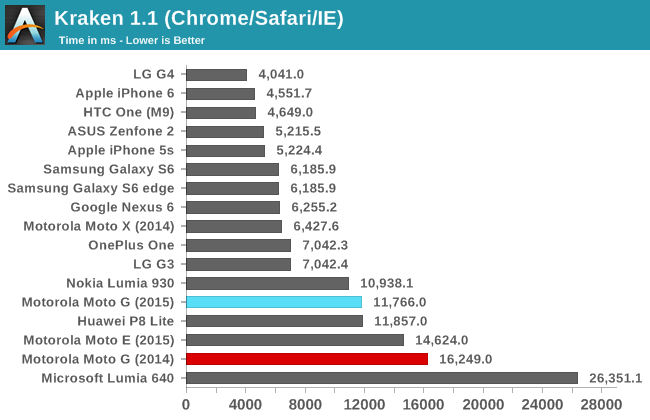
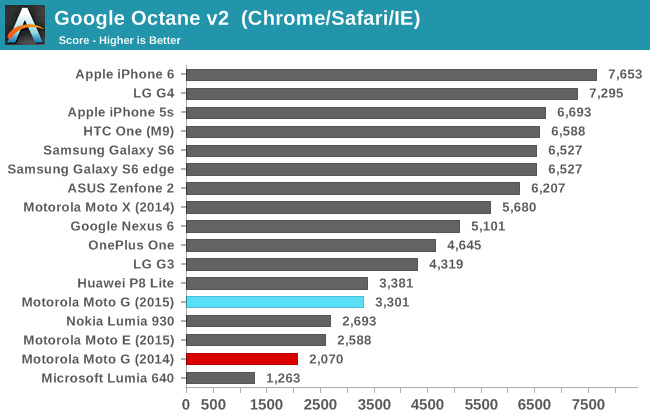
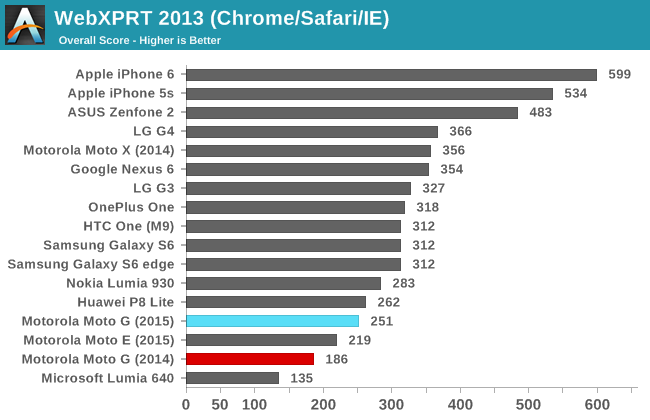

The overall picture painted by our web browser tests is that the 2015 Moto G has a healthy lead over the Moto E's performance, and an even greater one over the older Snapdragon 400 based models of the Moto G. The level of performance is certainly good for a $219 device, but I do find myself wishing that Snapdragon 410 and 615 were produced on 28nm HPC or 28nm HPm in order to achieve even greater performance without an increase to power consumption.

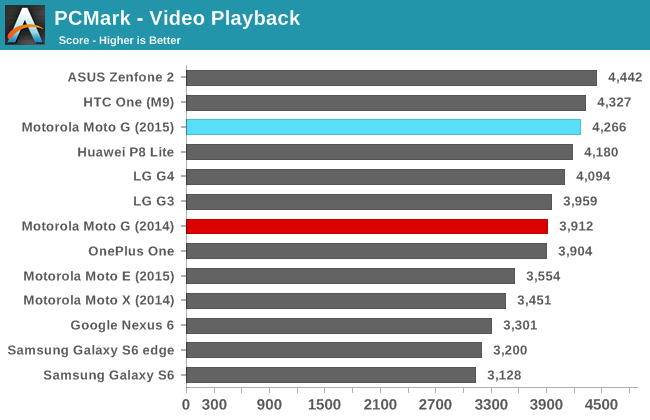
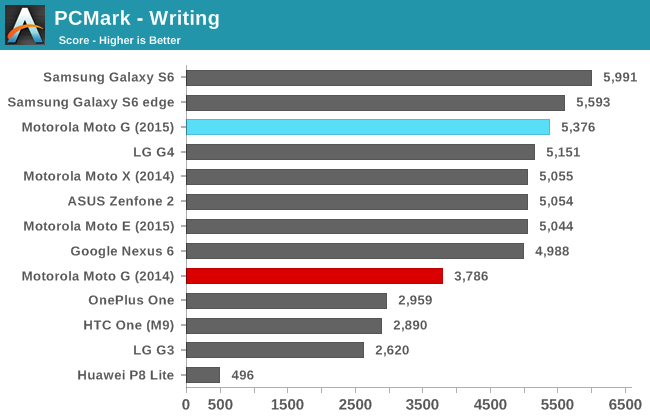
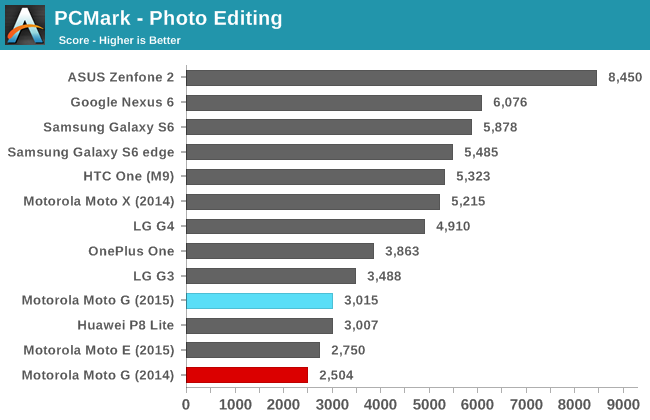
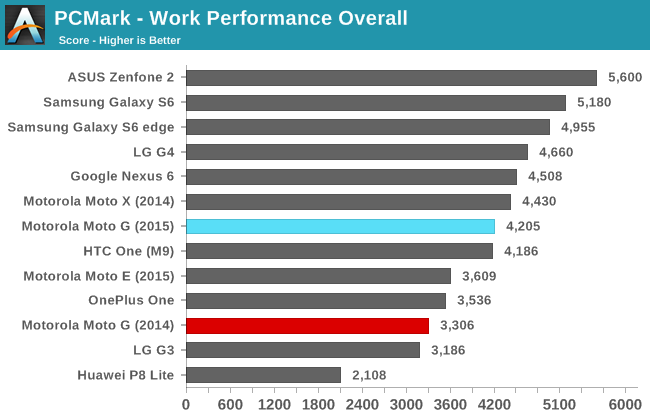
In PCMark, which focuses heavily on replicating real world tasks like watching video and editing photos, the 2015 Moto G again has a strong showing. Overall performance actually sits about the HTC One M9, carried by high scores in the writing and video playback tests. Web browsing performance also improves significantly from the 2015 Moto E and the 2014 Moto G, which could either be the result of additional memory or further optimizations to the Android WebView.
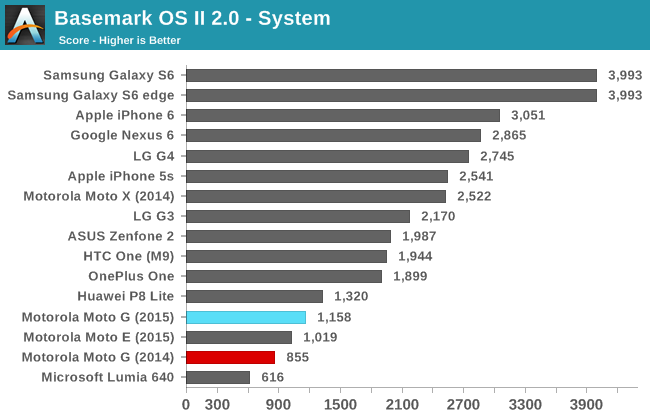
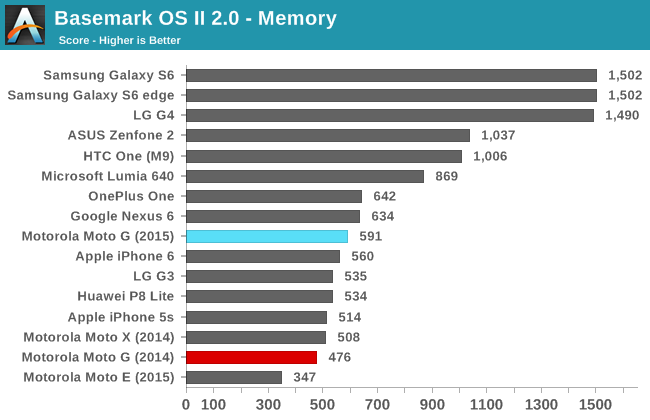

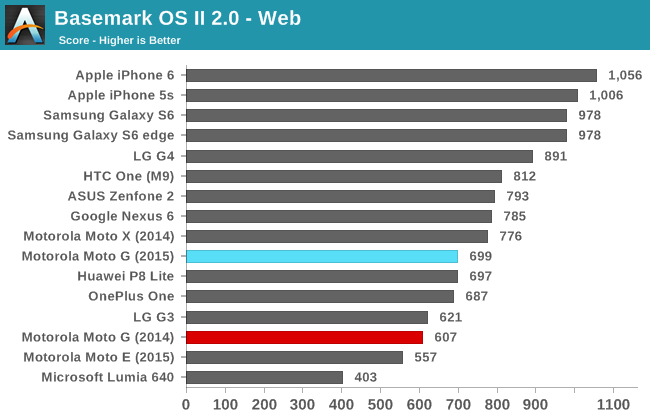
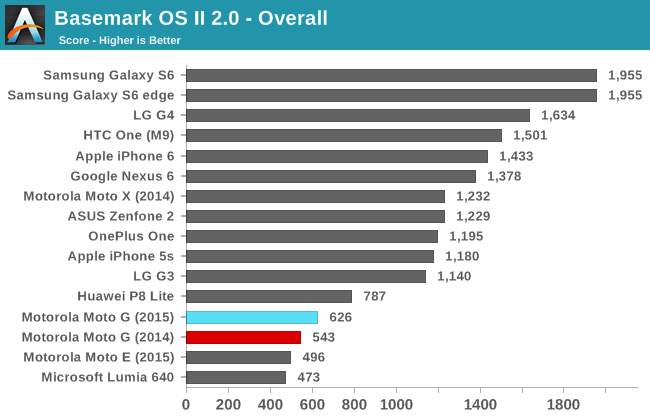
The Moto G doesn't perform as well in BaseMark OS II as it does in PCMark. While there's still good performance in the web and NAND memory sub-tests, performance lags in the system sub-test which stresses CPU and memory, and the graphics test score is very low due to how slow the Adreno 306 GPU is.
The Moto G's general performance is pretty good for a device of this price. There's a good level of improvement over the Moto E's performance, with the gap between the new Moto G and the 2014 model being even larger. The ASUS Zenfone 2 still has the best performance of a $200 smartphone, but it's something of an anomaly, and barring it the Moto G provides the best general performance that you'll see at this price point.










90 Comments
View All Comments
kmmatney - Wednesday, August 19, 2015 - link
They are in the $115 - $130 range on Swappa (at least the Sprint version). Of course that is used - but the phones I've bought from Swappa all looked brand-new when I received them. You can also get a used Galaxy S4 for ~$130, and will come with 2 GB of RAM and 16GB of storgae, and will be faster.Moto1 - Wednesday, August 19, 2015 - link
Nope, sorryamdwilliam1985 - Thursday, August 20, 2015 - link
Moto G 2015 will probably beat Galaxy S6 and Note 5 in general phone usage speed test, lol. So Galaxy S4 is probably not a good comparison to.3DoubleD - Wednesday, August 19, 2015 - link
It is not clear in the charging section whether the Moto G is limited to 2.75 W charging internally, or whether it is because a 2.75 W charger was used (because it was shipped with one). Could one conceivably use a 5 W or 10 W charger and cut the charge time in half or a quarter? This is not clear. I honestly didn't know they made 2.75 W chargers, the smallest charger I've ever seen is 1 A @ 5 V.Also, how crippling is this GPU performance? From what I can tell, an Adreno 305 is about 1/4 of the speed of the Nexus 5 (2013) in offscreen testing with Basemark X. But this doesn't describe the context of what it is like to use an Adreno 306 device. Does the UI studder? Does video playback work flawlessly? Does it play most games? Are there any notable games it does not play?
Also, I take issue with the comment that waterproofing is not a desirable feature because you can't use the display while wet. That is an insane comment to make! Most people would like some piece of mind that if their phone gets a little wet it won't become an expensive paper weight. That is a huge feature, especially considering the target market for this phone - a group that may likely be careless with their phone that it needs to be inexpensive and waterproof. So I'll say this in the comments since it wasn't said in the review: Motorola, good job making this phone waterproof.
Lastly, I don't think Motorola was praised enough for adding a bigger battery at the cost of not decreasing the thinness of the device. Phone manufacturers frequently shift the balance the wrong way, and finally Motorola stepped up and did it right.
Despite all of my question and critiques, I really appreciate the timely review! Thanks!
hans_ober - Wednesday, August 19, 2015 - link
Yeah, nice to see Moto worked on the battery and didn't go for 'omg 7mm slim' type of device.Thick phone > dead slim paperweight.
Brandon Chester - Wednesday, August 19, 2015 - link
1. It's just that the phone is shipped with a 2.75W charger. I will be listing a charge time using a 5W charging block, but to my knowledge there's no quick charge support so there's no additional advantage to using an even higher wattage QC 2.0 block2. You can play 2D games and very simple 3D ones like temple run, but there's not much hope for what one would call AAA mobile games. My big issue is the lack of GPU performance in mid range Android devices ends up limiting the availability and quality of those games on Android as a whole.
3. At no point did I ever say that waterproofing was not a desirable feature, or anything of that sort. I said it's nice to have, but I don't think it's a selling point. There's no evidence that any significant number of consumers are buying devices specifically because they're waterproof, so I don't think my observation was incorrect.
4. Not everyone shares the opinion that devices should get substantially larger to fit bigger batteries.
hans_ober - Wednesday, August 19, 2015 - link
Thanks. Yeah, theres no QC 2.0 support, but using 5W and even 10W chargers has reportedly cut short charging time. No harm in adding QC 2.0 to the graph too; it will show max possible charge rate, with the phone as bottleneck.Brandon Chester - Wednesday, August 19, 2015 - link
I'm just trying to kill the phone's battery now so I can charge it.hans_ober - Wednesday, August 19, 2015 - link
Having a bad time? :)hans_ober - Tuesday, August 25, 2015 - link
Update on charging time?